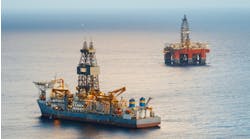Achieving progress through innovation
Judy Maksoud, International Editor
Deepwater remains a frontier for the oil and gas industry. That frontier brings with it the commercial and technical challenges of moving hydrocarbons into production in an exacting environment. The deepwater areas of the world contain significant reserves and remain one of the best exploration and development opportunities for oil companies, but reaching those reserves and bringing them into production pushes the limits of current technology.
The DeepStar program, a joint industry project launched in 1992, is one means of moving today’s technology into the future. One of DeepStar’s primary objectives is to identify and develop economically viable, safe, low-risk methods to produce hydrocarbons from deepwater.
According to Sean Hanrahan, DeepStar director, Chevron, DeepStar is the oil and gas industry’s best mechanism for adapting to the new deepwater market. “DeepStar delivers value by leveraging dollars and technical competency,” he says.
Through DeepStar, oil companies, vendors, regulators, academia, and research institutes cooperate to develop the technologies necessary to tackle deepwater, Hanrahan says. In doing so, each participant minimizes the cost and risk of developing the technology, while at the same time making the most of its particular technology achievements. In short, DeepStar offers participating companies the opportunity to significantly leverage their technology investment.
DeepStar brings together the industry’s leading experts in a common multi-discipline forum to address technical issues confronting deepwater production. The project has also established a working relationship with the US Minerals Management Service and US Coast Guard to resolve regulatory issues, which potentially affect safety aspects of design, implementation, and operation of future deepwater production systems.
DeepStar’s vision for the development of deepwater technology is closely tied to the concept of cooperation and evolution of a synergistic relationship among the members of the oil community.
Successfully developing deepwater fields requires significant improvements in production technologies as drilling more into deeper water and tackles smaller and more challenging reservoirs. The technology needs of the industry are significant, and no individual company has the resources - either financial or personnel - to research all the technology solutions the industry needs. Many of the necessary new technologies will require a jointly funded, cooperative effort, Hanrahan says.
Chevron Energy Technology Co., a division of Chevron USA Inc., administers the DeepStar program, which had its inception in 1992.DeepStar is a joint industry technology development project focused on advancing technologies to meet its members’ deepwater business needs.
In the program’s 14-year history, there have been seven phases, each made up of numerous projects with specific technical objectives. Over the years, the scope of the projects and objectives have expanded, with today’s technology goals pushing the limits further than ever before.
According to Jim Chitwood, technical coordinator for DeepStar, “In the early days, we did a lot of small projects. Now DeepStar undertakes fewer studies with greater technological depth and greater cost.” Average projects 12 years ago cost around $30,000. Today, an average project costs between $200,000 and $750,000, Chitwood says.
Contributors and their role
DeepStar is made up of operating companies (10 of which are participating in the current phase) and vendors (or to use the DeepStar vernacular, “contributors”), including drilling contractors, engineering companies, service companies, marine construction and transportation companies, and research groups, among others.
The DeepStar management committee comprises the 10 operating companies along with contributor representation. Including contributors on the committee lets vendors influence policy and allows them to voice their sometimes-differing views of vendor/operator issues.
According to Hanrahan, “One value in having contributors take part in DeepStar is that ultimately, operators will need these companies to carry forward the technology.”
John Allen, vice president strategic business development for Vetco International, explains that the vendor committee is made up of 53 companies, including all of the largest in the industry, as well as a significant number of medium and small companies.
Participating vendors pay a minimal fee to be a DeepStar contributor and commit to a larger in-kind contribution. Contributor participation ranges from attending committees to engaging in funded and unfunded studies and pilot activities.
The contributors have regular meetings at which invited operator organizations present their technology strategies and their technology venture capital plans. The contributors also organize workshops within DeepStar. This is one of the “in-kind” commitments each contributor is required to provide, Allen explains.
DeepStar funds the workshops (in terms of expenses), Allen says, but the contributors organize the workshops, which also provide content. “The workshops duplicate the DeepStar structure because you get both sides of the story,” Allen says.
The strength of this forum is that the vendors get extremely good engagement from the operators. “What that means,” Allen says, “is that DeepStar, in bringing together experts from a whole group of companies, can look at the different technologies on offer, and get feedback on how those technologies can benefit operator portfolios.” This arrangement allows contributors to determine how broadly applicable a given technology is. And it gives the operators an opportunity to voice issues and concerns about the technology in an open forum.
“You don’t get that anywhere else,” Allen says. “DeepStar is unique.”
The main value of DeepStar, according to Allen, is the systems engineering benefits. “We take cutting-edge field developments and ascertain what technologies will enable these developments to be technologically viable. We do that jointly, so we get an understanding from both sides the perceived value the new technology may provide. That in turn lets us develop a business case, which DeepStar or the contributors may further develop,” Allen says.
Within the JIP, a representative from one of the participating operating companies must act as “champion” for each of the research initiatives. The champion oversees and runs the research program and makes sure all of the administrative work that goes along with the project is carried out so the research program can keep accurate records and generate reports to identify the technological progress.
Participants in DeepStar
Owen Oakley, research consultant Chevron Energy Technology Co. and champion of a vortex induced vibration (VIV) research initiative for DeepStar, sees the value in DeepStar from the operator’s perspective.
“By being involved in DeepStar,” Oakley says, “we have an opportunity to have a strong say in the direction the research and development studies take. That allows us to address problems that are of particular interest to ourselves, but that are obviously of interest to the industry as a whole as well.”
Oakley’s personal area of interest is VIV research. “The topic is important and is one I’m quite interested in,” he says. Taking the role of “champion” was an obvious step. “I wanted to have a hand in directing VIV research,” Oakley says.
Research on highly technical subjects is so costly and requires so many resources that it is difficult for individual companies to finance the fundamental research needed, Oakley says. For that reason, DeepStar is an ideal vehicle to address technical challenges. “You get the greatest benefit from DeepStar if you’re intimately involved.”
If companies do not continue to support DeepStar and these kinds of research efforts, Oakley says, technological progress cannot occur fast enough to keep pace with the increasing demands of deepwater operations.
Mike Grecco, principal engineer, engineering and construction, at Unocal, has been the company’s senior advisor to DeepStar since Unocal became a participant. According to Grecco, Unocal has benefited from every area in which DeepStar is active.
As Unocal’s senior advisor, Grecco oversees what he calls the company’s ‘committee leads’ on each subcommittee. “The leads are technical experts in the fields they participate in at DeepStar,” Grecco explains. “Unocal has an in-house committee that follows each of the DeepStar sub-committees. Because the same engineers who are our project engineers are active in DeepStar, Unocal can rapidly implement the new technologies that DeepStar makes possible.”
According to Grecco, Unocal decided to re-enter deepwater in the late 1990s. The decision to participate in DeepStar immediately followed.
“When Unocal made a decision to get back into deepwater, we actively participated in a number of Gulf of Mexico lease sales and picked up a number of blocks, and with that, decided to get involved in DeepStar,” Grecco says. “We have seen tremendous benefit from our involvement.”
Investing in deepwater research was a priority for Petrobras long before DeepStar was formed, according to Orlando Ribiero, deepwater development coordinator, Petrobras America Inc. When Petrobras found the giant deepwater Marlim field in 1985, the deepest producing well was in about 400 m of water. Petrobras, realizing the critical need for deepwater technology, formed PROCAP, an initiative that would take technology from 400 to 1,000 m, Ribiero says.
“We achieved the objectives that we defined. We’ve seen value in our investment and tremendous results from the money we have spent,” Ribiero says. The decision to join DeepStar was a logical next step.
“We engaged in DeepStar around Phase I,” Ribiero says, an involvement that arose from a workshop in Rio, where Petrobras compared notes with DeepStar and realized there was a lot of common ground. “Today, the information we are gaining is much more valuable than when we first became involved in DeepStar because we are involved in deepwater operations in the Gulf both as partner and operator. The value is that we have access to all of the information that comes out of DeepStar research,” Ribiero says.
“I think DeepStar is a particularly good initiative because the environment here in the Gulf is so competitive that it does not stimulate cooperation among operators. In my mind, this is a missed opportunity. The real competition is to get the blocks. Once you get the blocks, you need to cooperate to secure the technology to develop the discoveries,” Ribiero says.
DeepStar today and tomorrow
DeepStar Phase VII began in January 2004 and will be completed by December. Phase VII goals include technology development for:
- Enabling 10,000-ft water depth production and transport
- Enhancing 4,000-6,000 ft water depth capabilities
- Delivering on the 50-mi tieback challenge for oil
- Addressing the HP/HT challenge in deepwater
- Improving the economic threshold for small stand-alone deepwater fields.
Working toward Phase VIII, DeepStar plans to tackle such subjects as identifying emerging business targets and establishing field development scenarios and evaluating them for state-of-development.
Continued funding for DeepStar will allow the JIP to pursue innovative technology to take oil and gas development safely into ever-deeper water and in the process, to reduce stakeholder risk.
Though the technology focus has evolved, DeepStar’s goals today are the same as they were at the inception of the program. DeepStar concentrates on enabling emerging technology and enhancing existing deepwater technologies by improving the profitability, operability, flexibility, and reliability of existing deepwater production systems.
DeepStar provides a forum for discussion, guidance, and feedback among participating companies, academia, and regulators, while funding the research that will move the oil and gas industry safely and profitably into even deeper water and more challenging reservoirs.
For more information about DeepStar, visit the JIP’s Web site at http://www.deepstar.org.
DeepStar, now in its 14th year and seventh phase, continues to play a leading role in developing deepwater technology.
DeepStar derives its value from leveraging the technical and financial resources of its members to advance technologies that meet common deepwater business needs. The Phase VII program contains 23 projects focused on enhancing current deepwater capabilities and developing new enabling technologies that will produce step changes in performance and enable safe, reliable, and economically feasible production to 10,000 ft water depth. Improving the economics of small deepwater fields will be a continuing challenge as the industry moves into deeper water and seeks to develop smaller reservoirs.
DeepStar continues to be at the leading edge of flow assurance technology advancement, in particular hydrates management. In fact, DeepStar has played a significant role over the last 10 years in the progression from hydrate prevention to hydrate management philosophy. Vortex induced vibration (VIV) is another technology in which DeepStar has played a key development role.
The high cost of deepwater exploration and production drives operators to enter into cost and risk-sharing partnerships. Developing deepwater technologies is unquestionably a high-cost endeavor. Deepwater technologies can present suppliers a limited market, particularly as operators are driving engineered solutions to match individual development plans. As a result, operators are required to take on a greater share of the technology development investment.
The solutions to many deepwater technology development challenges, such as flow assurance and VIV issues, are based on understanding the fundamental science of the technology. Establishing this level of understanding requires significant long-term investment in experiments, data collection, and validation. Because fundamental science technologies provide minimal competitive advantage to the service community, there is no incentive on an individual basis to invest heavily in technology development.
DeepStar, with its high investment leverage, offers operators a unique opportunity to leverage their technology spending to develop the technologies they and their deepwater partners need.
DeepStar engages contractors to leverage technical resources that reside in the contractor community. The collaborative nature of DeepStar, with its 10 operators and over 50 contractor members, ensures the industry’s best are engaged in deepwater technology development. DeepStar’s operator/supplier collaboration allows individual companies to make manageable investments that yield tangible and intangible benefits. Operators obtain value from the deployment of the newly developed technology, and the contracting community obtains value through supplying it.
Evolution in the offshore industry has led to increased outsourcing of front-end engineering, a business model that is not a best practice when million-dollar technology decisions are concerned. DeepStar is a mechanism for operators to grow deepwater technical competency. Through participation in DeepStar, oil companies can ensure their personnel stay abreast of industry developments. Involvement in DeepStar allows operators to stay current on deepwater technology development so they are in the best position to evaluate, deploy, and manage these technologies.
Finally, DeepStar plays an important role in technology acceptance by the Minerals Management Service and US Coast Guard. The value this brings to operators is reduced project approval schedule risk. MMS engagement in technology acceptance provides operators an edge when the new technologies are presented in a development plan.
Sean Hanrahan, DeepStar director, Chevron, leads DeepStar on behalf of the 10 participating oil companies. Sean has a BE in petroleum engineering from the University of New South Wales, Sydney, Australia, and an MBA from California State University. Sean joined Chevron in Australia in 1996. [email protected]




